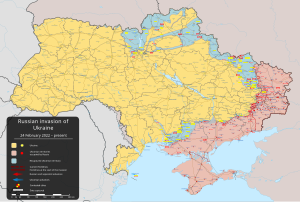
Russian invasion of Ukraine
Ongoing armed conflict in Eastern Europe / From Wikipedia, the free encyclopedia
Dear Wikiwand AI, let's keep it short by simply answering these key questions:
Can you list the top facts and stats about 2022 Russian invasion of Ukraine?
Summarize this article for a 10 year old
On 24 February 2022, Russia invaded Ukraine in a major escalation of the Russo-Ukrainian War, which started in 2014. The invasion, the largest conflict in Europe since World War II,[12][13][14] has caused hundreds of thousands of military casualties and tens of thousands of Ukrainian civilian casualties. As of 2024, Russian troops are occupying about 20% of Ukraine. From a population of 41 million, about 8 million Ukrainians had been internally displaced and more than 8.2 million had fled the country by April 2023, creating Europe's largest refugee crisis since World War II.
| Russian invasion of Ukraine | |||||||
|---|---|---|---|---|---|---|---|
| Part of the Russo-Ukrainian War (outline) | |||||||
 Map of Ukraine as of 21 July 2024 (details): | |||||||
| |||||||
| Belligerents | |||||||
|
Supported by: |
| ||||||
| Commanders and leaders | |||||||
| Units involved | |||||||
| Order of battle | Order of battle | ||||||
| Strength | |||||||
|
Pre-invasion at border: 169,000–190,000[lower-alpha 4][4][5][6] Pre-invasion total: 900,000 military[7] 554,000 paramilitary[7] In February 2023: 300,000+ active personnel in Ukraine[8] |
Pre-invasion total: 196,600 military[9] 102,000 paramilitary[9] July 2022 total: up to 700,000[10] September 2023 total: over 800,000[11] | ||||||
| Casualties and losses | |||||||
| Reports vary widely, see § Casualties for details. | |||||||
In late 2021, Russia massed troops near Ukraine's borders but denied any plan to attack. On 24 February 2022, Russian president Vladimir Putin announced a "special military operation", stating that it was to support the Russian-backed breakaway republics of Donetsk and Luhansk, whose paramilitary forces had been fighting Ukraine in the Donbas conflict since 2014. Putin espoused irredentist views challenging Ukraine's right to exist, falsely claimed that Ukraine was governed by neo-Nazis persecuting the Russian minority, and said that Russia's goal was to "demilitarise and denazify" Ukraine. Russian air strikes and a ground invasion were launched on a northern front from Belarus towards Kyiv, a southern front from Crimea, and an eastern front from the Donbas and towards Kharkiv. Ukraine enacted martial law, ordered a general mobilisation and severed diplomatic relations with Russia.
Russian troops retreated from the northern front, including from the outskirts of Kyiv, by April 2022 after encountering logistical challenges and stiff resistance. On the southern and southeastern fronts, Russia captured Kherson in March and Mariupol in May, the latter after a destructive siege. Russia launched a renewed offensive in the Donbas and continued to bomb military and civilian targets far from the front, including the energy grid through the winter months. In late 2022, Ukraine launched successful counteroffensives in the south and east. Soon after, Russia announced the illegal annexation of four partly-occupied oblasts. In November, Ukraine retook parts of Kherson Oblast, including Kherson city. In June 2023, Ukraine launched another counteroffensive in the southeast, which by the end of the year had failed with only small amounts of territory retaken.
War-related disruption to Ukrainian agriculture and shipping contributed to a world food crisis, while extensive environmental damage caused by the conflict have been described as an ecocide. The Russian attacks on civilians have led to allegations of genocide.[15][16][17][18] The invasion was met with widespread international condemnation. The United Nations General Assembly passed a resolution condemning the invasion and demanding a full Russian withdrawal in March 2022. The International Court of Justice ordered Russia to suspend military operations and the Council of Europe expelled Russia. Many countries imposed sanctions on Russia and its ally Belarus, and provided humanitarian and military aid to Ukraine. The Baltic states all declared Russia a terrorist state. Protests occurred around the world, with anti-war protesters in Russia being met by mass arrests and greater media censorship. The International Criminal Court (ICC) opened an investigation into war crimes, crimes against humanity, abduction of Ukrainian children, and genocide against Ukrainians. The ICC issued six arrest warrants: for Putin and Maria Lvova-Belova, and for military officials Sergey Kobylash, Viktor Sokolov, Sergei Shoigu and Valery Gerasimov.[19][20]